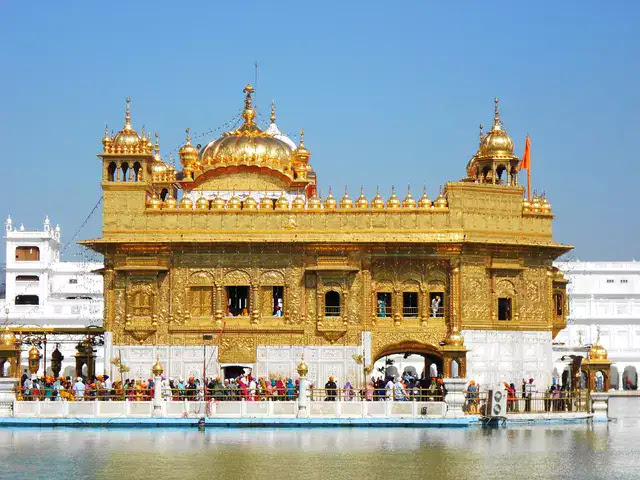Facts About Punjab - Welcome to a fascinating exploration of Punjab, a vibrant state located in the northwestern part of India. Known as the "Land of Five Rivers," Punjab captivates with its rich history, cultural heritage, and warm-hearted people. From the fertile agricultural lands nourished by the Beas, Chenab, Jhelum, Ravi, and Sutlej rivers to the iconic Golden Temple in Amritsar, Punjab offers a tapestry of captivating facts waiting to be discovered. Join us as we delve into the diverse facets of this remarkable region, renowned for its agricultural prowess, religious significance, dynamic festivals, lively music and dance, and much more. Let's embark on an enchanting journey to unravel 70+ intriguing facts about Punjab, where tradition and modernity coexist harmoniously, leaving an indelible mark on the cultural landscape of India.
70+ Interesting Facts About Punjab
- Punjab is a state located in the northwestern part of India.
- The name "Punjab" is derived from the Persian words "panj" meaning "five" and "ab" meaning "waters," referring to the five rivers that flow through the region.
- The five rivers of Punjab are the Beas, Chenab, Jhelum, Ravi, and Sutlej.
- Punjab shares its borders with the Indian states of Jammu and Kashmir, Himachal Pradesh, Haryana, Rajasthan, and the Pakistani province of Punjab.
- Chandigarh is the capital city of Punjab and also serves as the capital of the neighboring state of Haryana.
- Punjabi is the official language of Punjab. It is also one of the most widely spoken languages in India.
- The majority of the population in Punjab follows the Sikh religion, with Sikhs constituting over 57% of the state's population.
- The Golden Temple, located in the city of Amritsar, is the holiest shrine of Sikhism.
- Punjab is known as the "Land of Five Rivers" and the "Granary of India" due to its fertile agricultural land.
- Agriculture is the primary occupation of the people in Punjab, with wheat and rice being the main crops grown.
- Punjab is one of the leading producers of wheat in India and is often referred to as the "Wheat Bowl of India."
- The Green Revolution, a period of significant agricultural growth, was first implemented in Punjab in the 1960s, leading to a substantial increase in agricultural productivity.
- Punjabi cuisine is known for its rich and flavorful dishes. Some popular Punjabi dishes include butter chicken, sarson da saag, makki di roti, and paneer tikka.
- Bhangra is a lively and energetic folk dance form that originated in Punjab and is now popular worldwide.
- Punjab has a rich history dating back thousands of years. It was part of the ancient Indus Valley Civilization and has witnessed the rule of various empires and dynasties.
- The Maurya Empire, Gupta Empire, and Kushan Empire all had a significant presence in Punjab during ancient times.
- The region of Punjab witnessed the invasion of Alexander the Great in 326 BC.
- The Sikh Empire, led by Maharaja Ranjit Singh, was established in Punjab in the early 19th century and lasted until the mid-19th century.
- The Jallianwala Bagh massacre, a tragic incident during the British colonial period, took place in Amritsar, Punjab, in 1919, resulting in the death of hundreds of unarmed civilians.
Facts About Punjab for Kids
- Punjab played a crucial role in India's struggle for independence from British rule, with many freedom fighters hailing from the region.
- The Partition of India in 1947 resulted in the division of Punjab between India and Pakistan. The Indian part became the state of Punjab, while the Pakistani part became the province of Punjab in Pakistan.
- Punjab is home to several historical and religious sites, including the Anandpur Sahib, Fatehgarh Sahib, and Takht Sri Patna Sahib Gurudwaras.
- The Punjabi festivals of Baisakhi and Lohri are widely celebrated with great enthusiasm in Punjab.
- Punjab has a vibrant music and film industry. The Punjabi music industry produces a wide range of music genres, including Bhangra, Punjabi pop, and folk music.
- The famous Punjabi poet and philosopher, Baba Farid, is widely respected and revered in the region.
- Punjab is known for its martial heritage, with many brave warriors and soldiers hailing from the state.
- The Wagah Border, located near Amritsar, is the only road border crossing between India and Pakistan and is known for the elaborate border ceremony that takes place every day.
- Punjab is renowned for its warm hospitality and welcoming nature of its people.
- The sport of Kabaddi, a traditional Indian game, is extremely popular in Punjab, with many talented players coming from the state.
- The Punjab Cricket Association Stadium in Mohali is a prominent cricket venue in India and has hosted many international matches.
- Punjab is known for its colorful and vibrant festivals, including Hola Mohalla, which is celebrated with great fervor in Anandpur Sahib.
- The state of Punjab has a strong presence in the Indian armed forces, with many individuals serving in the army, air force, and navy.
- Punjab is home to several wildlife sanctuaries and national parks, including the Harike Wetland, Abohar Wildlife Sanctuary, and Bir Moti Bagh Wildlife Sanctuary.
- The city of Ludhiana in Punjab is known as the "Manchester of India" due to its thriving textile industry.
- Punjab has a well-developed road and rail network, connecting it to various parts of India and neighboring countries.
- The Bhakra Nangal Dam, located on the Sutlej River in Punjab, is one of the highest gravity dams in the world.
- The state of Punjab has made significant contributions to the field of literature, with renowned writers and poets like Amrita Pritam and Shiv Kumar Batalvi emerging from the region.
Amazing Facts About Punjab
- Punjabi folk dances, such as Giddha and Sammi, are an integral part of the region's cultural heritage.
- The Punjab Agricultural University, located in Ludhiana, is a leading agricultural research institution in India.
- Punjab is known for its vibrant and colorful traditional attire, with men often wearing a turban and women adorning bright and intricately embroidered salwar kameez.
- Punjabi is also spoken by a large diaspora community around the world, particularly in countries like the United Kingdom, Canada, and the United States.
- The state of Punjab has a well-developed education system, with numerous universities, colleges, and schools offering quality education.
- Punjabi cinema, popularly known as "Pollywood," has gained recognition for its unique storytelling and entertaining movies.
- The Anand Karaj ceremony, a Sikh wedding ceremony, is a significant cultural event in Punjab, marked by grand celebrations and traditional rituals.
- The folk instrument known as the "dhol" is widely used in Punjabi music and is known for its energetic and rhythmic beats.
- Punjab is home to the famous "Phulkari" embroidery, which is characterized by intricate floral designs and vibrant colors.
- The Punjab and Haryana High Court, one of the oldest high courts in India, is located in Chandigarh and serves as the common high court for both states.
- Punjab has a rich tradition of craftsmanship, with artisans skilled in various crafts like pottery, woodwork, and phulkari embroidery.
- The Punjabi language has its unique script known as Gurmukhi, which is derived from the Landa script.
- Punjabi literature has a diverse range of literary genres, including poetry, short stories, novels, and plays.
- Punjab is known for its numerous historical forts and palaces, including the Gobindgarh Fort in Amritsar and the Sheesh Mahal in Patiala.
- The Punjabi film industry has produced many renowned actors and actresses who have gained popularity in Bollywood as well.
- Punjabi weddings are known for their extravagant celebrations, with vibrant decorations, music, dance, and delicious food.
- The state of Punjab has a significant Sikh pilgrimage site known as Hemkund Sahib, located in the Himalayan region.
- Punjabi culture promotes values of community, togetherness, and respect for elders.
- The Punjab Heritage and Tourism Promotion Board actively promotes tourism in the state, showcasing its rich cultural heritage and historical landmarks.
- Punjab has a diverse and inclusive society, with people from different religions and communities living harmoniously.
- The town of Kapurthala in Punjab is known for its architectural beauty and is often referred to as the "Paris of Punjab."
Famous Things About Punjab
- Punjab is known for its love for sports, and wrestling is particularly popular, with Punjab producing many renowned wrestlers.
- The Punjabi language has a rich literary tradition, with famous poets like Waris Shah, Bulleh Shah, and Shiv Kumar Batalvi contributing to its rich poetic heritage.
- The state of Punjab has a strong tradition of folk music, with instruments like the harmonium, tabla, and tumbi being commonly used.
- Punjab has a significant presence of Sikh gurudwaras, with each having historical and religious importance.
- The state government of Punjab has implemented several welfare schemes to uplift the rural and marginalized sections of society.
- Punjab is known for its vibrant festivals like Basant Panchami, Gurpurab, and Teej, which are celebrated with great enthusiasm.
- The Punjab Agricultural University in Ludhiana is renowned for its research and development in the field of agriculture and agricultural engineering.
- The state government of Punjab has implemented various initiatives to promote renewable energy, such as solar power projects and bioenergy plants.
- Punjabi culture places great importance on family values and traditions, with joint families being prevalent in many communities.
- Punjab has a rich tradition of folk arts and crafts, including Phulkari embroidery, Punjabi jutti (traditional footwear), and clay pottery.
- The state of Punjab has a well-developed healthcare system, with several government and private hospitals providing quality medical services.
- The Punjabi film industry has gained international recognition, and Punjabi movies are screened in various countries with Punjabi diaspora communities.
- The city of Amritsar is home to the Partition Museum, which preserves the history and stories of the Partition of India in 1947.
- Punjab has a strong tradition of martial arts, with Gatka being a popular martial art form practiced in the region.
Friends, hope you liked this post of Suprising Facts About Punjab. If you liked this post, then you must share it with your friends and Subscribe to us to get updates from our blog. Friends, If you liked our site FactsCrush.Com, then you should Bookmark it as well.














0 Comments